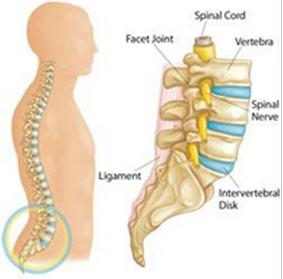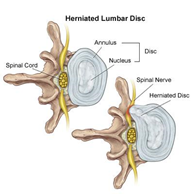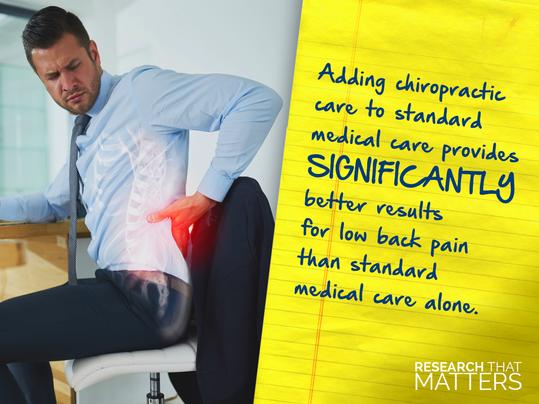Do I Have a Herniated or Bulging Disc?

A Primer on Lumbar Disc Disorders
Your back hurts. A LOT. And not just your back. Your leg is weaker than it used to be. Numb and tingling, possibly.
And someone said you may have a bulging disc.
Or a herniated disc.
Both of these sound rather horrific.
They sound irreversible and painful and maybe life will never be like it used to be. They can be painful, it’s true.
But, you’ll be glad to know that they are not irreversible. Life can return to “normal” - or even better than normal.
AND most lumbar disc problems do not demand surgery.
At Daniels Chiropractic our Racine, Caledonia, and Mt. Pleasant chiropractors have over 70 years of experience and specialize in helping you get better. It is our mission to help you feel, move, and live better.
That means that, first, we try to relieve the pain as much as possible. Next, we make a plan for treatment that will restore joint function and mobility (how you get around and do all of the stuff you used to do). Once you get moving again, we don’t want to stop there. We want to help you become stronger and able to fully engage in life and work - better than you’ve been in a long while.
This article is 4th in a series on low back pain.
So far we have covered:
- Part 1: Protecting Your Back From Pain: How to Sit, Stand, Move and Work to Prevent Back Pain
- Part 2: Back Strains and Sprains Are A Pain (Lumbar Strains and Sprains)
- Part 3: Lumbar Stenosis
After this article on lumbar disc disorders we will finish up with facet syndrome and lower crossed syndrome (often associated with prolonged sitting).
Now, back to bulging and herniated discs. There are a few things that are helpful to understand.
Let’s start with the basics.
What is the lumbar spine?
The lumbar spine is made up of five bone segments called vertebrae located at the bottom of the spine between the ribs and pelvis. In between each vertebra are flexible discs. They act like shock absorbers for the spine.

Each vertebra has:
- A tough outer ring of fibrous tissue called the annulus fibrosus.
- And a jelly-like center (inside the annulus fibrosus) called the nucleus pulposus.
The vertebrae and discs are held together by ligaments on the front and the back of the vertebrae. Then, of course, muscles are attached throughout and complete the support of the spine.
How do the discs bulge or become herniated?
In most cases, lumbar discs change as a result of normal aging. Doctors call it disc degeneration. Disc degeneration causes structural changes to the normal disc.
In the normal aging process, the tissues of the disc begin to lose fluid (water) and, with that, they lose elasticity. As they dry out they begin to compress (without the fluid to keep the tissue full). A result can be that the tough outer ring of the disc breaks down. When this happens the inner core can begin to bulge out. Hence, the term “bulging disc.”
This bulging disc puts pressure on the nerve root, sending pain that radiates down the back and possibly the leg. If the disc degenerates further, the outer portion of the disc tears and the inner core may rupture out. This is what is called a ruptured, or herniated, disc.
In some cases pain may improve when the disc is herniated.

However, the fragmented disc material may still inflame and put pressure on the spinal nerves and result in a LOT of pain.
Am I at risk for a bulging or herniated disc?
There are a few risk factors. And the more you have, the greater the chance of developing a bulging or herniated disc.
Age and Gender
Most disc problems occur in men between the ages of 30 and 50. Of course, women can suffer, too.
Excess Weight
Carrying around extra weight puts added stress on lumbar discs.
Inactivity
A sedentary lifestyle can set you up for a disc problem. When we don’t move and get enough exercise we lose core body strength. Then the discs are more vulnerable to injury.
Smoking
Smoking decreases the oxygen supply to the discs and this causes more rapid degeneration.
Poor Body Mechanics
Lifting heavy loads improperly - using more of the back muscles and less of the legs - can cause injury. Also, twisting the torso while lifting a heavy load leads to disc problems.
Posture
When the lower spine arches too much and the pelvis tilts forward, too much pressure is put on the lumbar discs.
Repetitive Straining
If your job demands constant lifting, pulling, bending, or twisting, your discs may suffer eventually.
Frequent Driving
Staying seated for long periods of time, in addition to the constant vibration from the car, can put pressure on your discs and damage them.
Severe Trauma
Occasionally, severe trauma can cause a normal disc to herniate. Or it could cause an already herniated disc to worsen. This is not a common risk factor, but it is a possibility.
Now that you know your own risk factors, you may be more suspicious of your pain. Is it a herniated disc? A bulging disc? Let’s look at the typical symptoms for a bulging or herniated disc.

What are the symptoms of a bulging disc or herniated disc?
You may have one or a combination of the following symptoms:
- Intermittent or constant lower back pain.
- Intermittent or constant pain in the buttock area.
- Intermittent or constant leg and foot pain.
- Numbness or a tingling sensation in the leg and/or foot.
- Sciatic leg pain.
- Weakness in the leg and foot.
- Decreased reflexes in the knee or ankle.
- Changes in bowel or bladder function.
Depending on which disc is suffering, your symptoms will vary. Your pain also depends on if the disc has herniated or if it is bulging, and which spinal nerve root is affected.
For example, leg pain is usually greater than low back pain with disc herniations and nerve root involvement. OR, if the disc is only bulging, your pain will just be in the low back and buttock.
Some people say that their pain came on suddenly; some say it comes on gradually. You may notice a problem right after a certain motion like twisting, straining, or lifting something heavy. Sometimes, you can’t even recall when and why the pain started. That’s ok. We can still get to the bottom of it and help you get better.
Typically, the kind of pain you feel with a disc disorder is sharp, shooting, or electrical pain. You may notice that your pain is increased by certain movements like changing positions or sneezing and coughing. Or you may feel the onset of pain after prolonged sitting or standing.
Everyone’s body and experience is a little different. Most people can get some relief by lying down, finding a comfortable position and resting a while. But, obviously, you can’t stay in bed all day. You need to get treatment if you are in pain like this.
Come See Us
Your first few days of care will focus on reducing your pain by decreasing the inflammation at the disc site and by manual therapy to decompress the nerve root. We will educate you on ways to protect your lower back, positions to avoid, and how to manage your daily activities to avoid pain.
Typically, we do not recommend extended bed rest. The sooner you are up and moving, even if slowly and gingerly, the better your outcome will be. But, we can help you do this safely. Once your pain decreases we will work on stabilizing your lower back and then progress into balance and core exercises.

When you come into Daniels Chiropractic for care we always determine if you are in the right spot for the care you need. If another form of care would serve you better, we will refer you to other primary & specialty care providers.
Also, if you fail to respond to chiropractic care and strengthening exercises, or in cases of severe neurological loss, we will refer you for a surgical consultation.
So, do you think you have a bulging or herniated disc? Come see us. We want to help you get better at Daniels Chiropractic.
Daniels Chiropractic Office
2609 Rapids Drive
Racine, WI 53404
Phone: 262.638.9999
Fax: 262.638.0742
Source:
This article produced with the help of the Chiropractic Success Academy.
